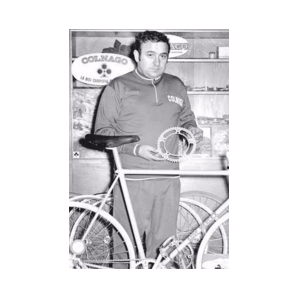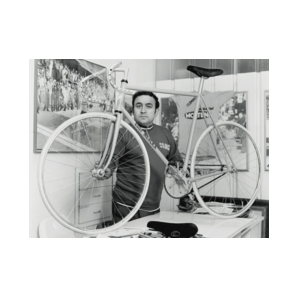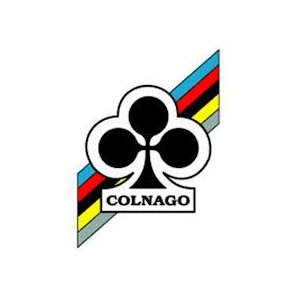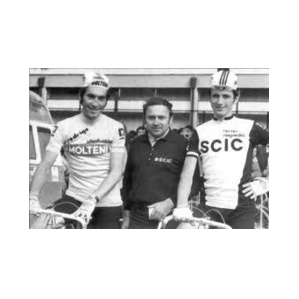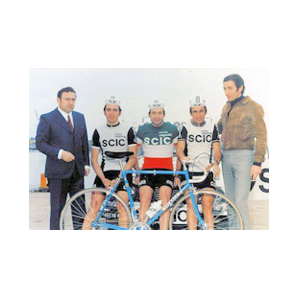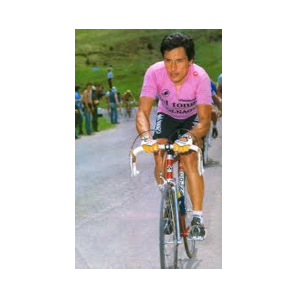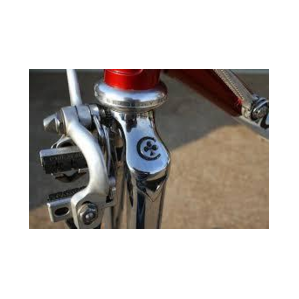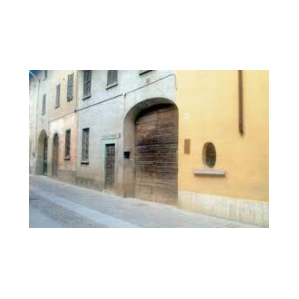Colnago
Storia di Colnago

Colnago è un produttore di biciclette da corsa di alta gamma fondata dallo stesso Ernesto Colnago e dal fratello Paolo, vicino a Milano a Cambiago, in Italia. Invece di seguire l'attività agricola della sua famiglia, Ernesto Colnago scelse di lavorare nel settore del ciclismo, facendo apprendistato prima presso l’azienda di biciclette Gloria dove a 13 anni iniziò il suo apprendistato, cambiando la data di nascita sui documenti. Dopo un brutto incidente terminò la sua carriera agonistica, ed iniziò a lavorare a casa per la Gloria. Aprì il suo negozio nel 1954, costruendo i suoi primi telai nello stesso anno. Durante la costruzione di telai, fu richiesto anche come meccanico per un team professionistico. Infatti fu il secondo meccanico del Giro d'Italia del team Nivea sotto Faliero Masi nel 1955, e quindi fu capo meccanico per il team Molteni della leggenda del ciclismo belga Eddy Merckx dal 1963.
La società Colnago è diventata prima nota per le biciclette con telaio in acciaio di alta qualità adatte per l'ambiente esigente delle corse professionistiche, e in seguito come uno dei produttori di ciclismo più creativi responsabili delle innovazioni nel design e nella sperimentazione di materiali nuovi e diversi tra cui la fibra di carbonio.
Una delle prime grandi vittorie su un telaio Colnago risale al 1957, quando Gastone Nencini vinse l'edizione del 1957 del Giro d'Italia su una bicicletta Colnago. Nel 1960, Colnago ottenne un maggiore riconoscimento quando Luigi Arienti ottenne la medaglia d'oro alle Olimpiadi di Roma sempre su una bicicletta Colnago. Alla fine degli anni '60, Colnago era generalmente considerato come uno dei migliori costruttori dei telai da corsa su strada personalizzati al mondo.
Mentre Ernesto era il capo meccanico del team Molteni, ciclisti come Gianni Motta hanno corso su biciclette Colnago. Una vittoria su una Colnago nella gara Milano-Sanremo del 1970 di Michele Dancelli per il team Molteni ha ispirato Colnago a cambiare il suo logo nell'ormai famoso "Asso di Fiori" . Originariamente il logo colnago prevedeva una aquila con una freccia nel becco. Dopo la scomparsa del team Faema, Eddie Merckx si unì al team Molteni e ciò che ne conseguì fu l'innovazione reciproca, come la descrive Colnago: "Merckx era un campione emergente e io ero un costruttore di biciclette emergente. Quindi era un vero onore a lavorare per un grande campione come Merckx. Ci ha aiutato a crescere e insieme abbiamo realizzato forcelle speciali e biciclette speciali ". ad esempio Colnago creò il telaio in acciaio superleggero usato da Merckx nel 1972 per battere il record mondiale di un'ora.
Con una crescente reputazione grazie alle loro vittorie nelle corse, Colnago iniziò la grande produzione in serie delle biciclette. Negli Stati Uniti, i primi anni Settanta furono testimoni di un altro boom delle biciclette e Colnago fu subito presente in questa enorme mercato. Il pilastro della linea Colnago negli anni '70 era il Super, seguito dal Messico, nominato in onore del riuscito tentativo del record dell’ora di Merchx. Altri modelli furono aggiunti tra cui il Superissimo ed Esa Mexico. Erano fantastiche bici da corsa . Nel 1979, Ernesto Colnago regalò a Papa Giovanni Paolo II una bicicletta in acciaio placcata oro personalizzata. In risposta alle critiche sul fatto che i suoi telai non fossero abbastanza rigidi, Colnago ha poi sperimentato modi per cambiare il comportamento del telaio. Nel 1983, ha introdotto l'Oval CX con un tubo superiore di forma ovale per aggiungere rigidità. Ha quindi sperimentato vari telai con tubi dalla forma stellare, che sono diventati modelli di produzione come i loro telai di alta gamma, a partire dal "Master". Successivamente "Master-Light", Master Olympic e Master Più hanno ampliato la gamma. Colnago costruì un telaio in tubo Columbus usato da Giuseppe Saronni per vincere il campionato mondiale di corse su strada nel 1982, e in seguito una collezione di biciclette di breve durata fu contrassegnata con il nome Saronni. Nel 1983, Giuseppe Saronni vinse il suo secondo Giro d'Italia di nuovo con una bicicletta Colnago.
Dagli anni '80, Colnago ha continuato a produrre biciclette in acciaio di alta gamma, ma ha iniziato anche a produrre telai per biciclette utilizzando materiale diverso dall'acciaio tra cui titanio, alluminio, carbonio e telai in materiali misti. Il modello Arabesque era il telaio in acciaio di alto livello nella produzione Colnago, e nel 1984 Colnago decise di produrre un telaio Arabesque con il 30° gruppo Colnago-Campagnolo per festeggiare i 30 anni di attività dell’azienda.

Colnago is a high-end racing bicycle manufacturer founded by Ernesto Colnago and his brother Paolo, near Milan in Cambiago, Italy. Instead of following his family's agricultural activity, Ernesto Colnago chose to work in the cycling sector, first apprenticeship at the Gloria bicycle company where he began his apprenticeship at the age of 13, changing the date of birth on the documents. After a bad accident he ended his competitive career, and started working at home for Gloria. He opened his shop in 1954, building his first frames in the same year. During the construction of frames, he was also requested as a mechanic for a professional team. In fact he was the second mechanic of the Giro d'Italia of the Nivea team under Faliero Masi in 1955, and therefore he was chief mechanic for the Molteni team of the Belgian cycling legend Eddy Merckx from 1963.
The Colnago company first became known for high-quality steel frame bicycles suitable for the demanding environment of professional racing, and later as one of the most creative cycling manufacturers responsible for innovations in the design and experimentation of new materials including carbon fiber.
One of the first great victories on a Colnago frame dates back to 1957, when Gastone Nencini won the 1957 edition of the Giro d'Italia on a Colnago bicycle. In 1960, Colnago gained greater recognition when Luigi Arienti obtained the gold medal at the Rome Olympics always on a Colnago bicycle. In the late 1960s, Colnago was generally regarded as one of the best manufacturers of custom road racing frames in the world. While Ernesto was the chief mechanic of the Molteni team, cyclists like Gianni Motta, winner of 1966 Giro d’Italia, raced on Colnago bicycles. The Dancelli’s victory , a cyclist of Molteni team, in Milan-Sanremo of 1970, inspired Colnago to change its logo in the now famous "Ace of clubs". Originally the colnago logo featured an eagle with an arrow in its beak. After the disappearance of the Faema team, Eddie Merckx joined the Molteni team and what followed was mutual innovation, as Colnago describes it: "Merckx was an emerging champion and I was an emerging bicycle frame builder. So it was a real honor to work for a great champion like Merckx. It helped us to grow and together we made special forks and special bicycles ". For example Colnago created the superlight steel frame used by Merckx in 1972 to break the world one hour record.
With a growing reputation thanks to their racing victories, Colnago began mass production of bicycles. In the United States, the early 1970s witnessed another bicycle boom and Colnago was immediately present in this huge market. The pillar of the Colnago line in the 70s was the Super, followed by Mexico, named in honor of the successful attempt of the Merchx one hour record. Other models were added including the Superissimo and Esa Mexico. They were fantastic racing bikes. In 1979, Ernesto Colnago gave Pope John Paul II a personalized gold-plated steel bicycle. In response to criticism that his frames were not rigid enough, Colnago then experimented with ways to change the behavior of the frame.
In 1983, he introduced the Oval CX with an oval shaped top tube to add rigidity. He then experimented with various frames with star-shaped tubes, which have become production models such as their high-end frames, starting with the "Master". Subsequently "Master-Light", Master Olympic and Master Più expanded the range. Colnago built a Columbus tube frame used by Giuseppe Saronni to win the world road racing championship in 1982, and later a collection of short-lived bicycles was marked with the Saronni name. In 1983, Giuseppe Saronni won his second Giro d'Italia again with a Colnago bicycle.
Since the 1980s, Colnago has continued to produce high-end steel bicycles, but has also started producing bicycle frames using material other than steel including titanium, aluminum, carbon and mixed material frames. The Arabesque model was the high-level steel frame in Colnago production, and in 1984 Colnago decided to produce an Arabesque frame with the 30th Colnago-Campagnolo group to celebrate the company's 30 years of activity.
Colnago models
Colnago Mexico - Colnago began production of the Mexico as a celebration of Eddy Merckx’s world hour record in 1972, built with thin Columbus tubes for less weight and responsive handling. The Mexico was always equipped with the best components available – traditionally a Campagnolo groupset and finely made Italian finishing kit.
Colnago Super - During a period when the bicycles of the Giro and Le Tour were heavyweights with extended riding positions, Colnago released the Super – compact top tubes and low head tubes for a low, aerodynamic position. A frame which soon became the landmark for all racing bikes.
Colnago Master - The Master had completely different lugs and drastically changed tubing to the Mexico, including a unique ‘crimped’ design to increase stiffness and power transfer. Avid collectors are quick to purchase original Master’s, either as a piece of art to display or an example of mechanical craft to ride.
Colnago Oval CX - The Oval CX represents the genesis of aerodynamic bicycle design. Modern superbikes in mass production like the Specialized Venge, Giant Propel and Scott Foil all owe their design to the Oval CX.
Colnago Mexico Oro - Many Colnago Mexico’s were produced, but some were particularly special. Some were chromed and a few were gold plated (one of these was presented to the Pope).
Colnago Arabeqsque - It was produced between 1984 and 1985 to celebrate the thirtieth anniversary of the company: Ernesto Colnago wanted to create a bicycle which would become milestone in the bicycle industry.








